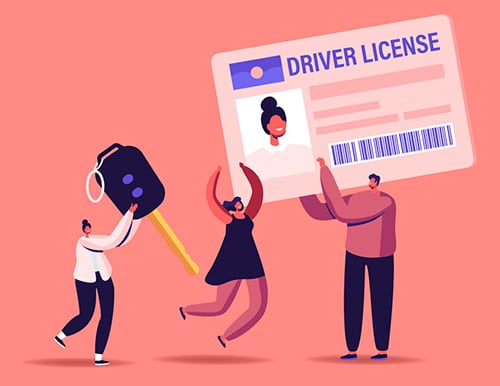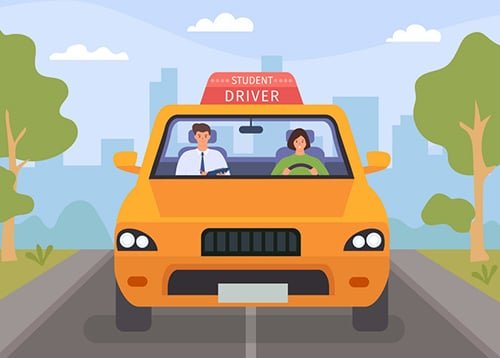
How to Get a Driver’s Licence in Ontario
The Ultimate Guide to Getting a Driver's Licence in Ontario
If you want to get a driver’s license in Ontario, Canada, there are specific rules and requirements you are going to need to adhere to. In this blog post, we will take you through everything you need to know.
Ontario Driver's Licence Requirements
In order to get a driver’s license, residents of Ontario need to be a minimum of 16-years-old, and you need to pass your driving test. In Ontario, there is a graduated licence system in place, which helps in terms of lowering the risks new drivers face, especially if you are driving in an area with snow and ice.

You will need to complete the graduated license system in order to possess a full driver’s licence. In Ontario, this means starting off with a G1 licence, moving onto a G2 licence, and then to a full G licence. This is something we will explain in more detail in the next section.
To achieve this, you will need to complete two road tests and one written exam. The system is created so that drivers get plenty of hands-on experience before they start to drive on their own.
Table of Contents
Driver’s Licence Classification
- Class A – This licence enables you to drive any tractor-trailer combination. You can also drive in class G and D.
- Class B – This licence enables you to drive any school purposes bus. You can also drive in class C, D, E, F, and G.
- Class C – This licence enables you to drive any regular bus. You can also drive in class D, F, and G.
- Class D – This licence enables you to drive any motor vehicle in excess of 11,000 kg gross weight or registered gross weight. You can also drive any truck or combination provided the vehicle being towed is not more than 4,600 kg. You can also drive in class G.
- Class E – This licence enables you to drive any school purposes bus with a maximum of 24 passengers. You can also drive in class F and G.
- Class F – This licence enables you to drive any regular bus with a maximum of 24 passengers. This includes ambulances as well. You can also drive in class G.
- Class G – This licence enables you to drive any small truck, van, and car, or a combination of vehicle and towed vehicle, so long as the vehicle being towed does not exceed 4,600 kg. The vehicle itself must not exceed 11,000 kg. The combined weight of the trailer and truck can also not exceed 11,000 kg.
- Class G1 – This represents level one of graduated licensing. Holders can drive any Class G vehicle with an accompanying fully licensed driver that has a minimum of four years worth of experience. There are certain conditions that need to be met.
- Class G2 – This represents level two of graduated licensing. Holders can drive any Class G vehicle without an accompanying fully licensed driver. There are certain conditions that need to be met.
- Class M – This licence enables you to drive any motorcycle, including motor-assisted bicycles, limited-speed motorcycles, and motor tricycles. You can also drive in class G, so long as you are under the conditions that are applicable to a Class G1 licence holder.
- Class M1 – Let’s you drive class M vehicles for learning purposes for up to 90 days. No highways, no night driving, and no alcohol.
- Class M2 – Most of the restrictions from M1 are gone, but still no alcohol. You must hold an M1 Licence at least 60 days before attempting the riding test.
Graduated Licensing
New drivers making an application for their first motorcycle or vehicle need to enter the graduated licensing system in Ontario. Graduating licensing enables new drivers to get driving skills and experience gradually. This two-step licensing process will take a minimum of 20 months to complete.
To make an application for a licence, you are going to need to be a minimum of 16-years-old, pass a test of your knowledge regarding traffic and road signs, and pass a vision test. Once you have passed these tests, you are then going to be able to get a Class G1 and Level One licence.
In order to become fully licensed, you will need to pass two road tests. If you pass the first road test, you are then going to be able to move onto a Class G2 licence. This will enable you to enjoy full Class G driving privileges.
Applying For a Licence
In order to apply for a licence, you will need to provide proof of your legal name, a signature, and your date of birth. All documents need to be valid and original. It is not acceptable to provide expired documents or photocopies.
Proof of identification
You can use any of the following to prove your identity:
- Temporary immigration documents
- Permanent immigration documents
- Canadian Citizenship Card with photo
- Passport
Additional documents
Additional documents will be needed if the document presented for your ID does not indicate your signature, date of birth, or legal name.
For proof of legal name and date of birth, you can provide a U.S. or Canadian birth certificate.
For proof of signature, you can use your Ontario health card, Ontario student card, Canadian Certificate of Indian Status, Identity card, or U.S. or Canadian Driver’s Licence.
Proof of legal name
Additional documents that will be accepted to prove your legal name include court order for adoption, change of name certificate, and marriage certificate.
Declaration from a guarantor
If you cannot provide the documents mentioned above, you may be able to present a completed, original declaration from a guarantor form attesting to their signature.
Fees
Graduated Licensing Requirements
Level One (Class G1)
Level One will last for 12 months. The following rules apply:
- You cannot drive between midnight and 5 am.
- You cannot drive on a 400-series highway with a posted speed limit exceeding 80 km/h.
- Every passenger must have a working seatbelt.
- You cannot drive alone and the accompanying driver needs to be in the front passenger seat.
- You cannot drive if you have been drinking alcohol.
G1 knowledge test
You will need to study the Official MTO Driver’s Handbook to pass this test. Make sure you do not forget money for the test fees and two pieces of identification.
G1 exit test
You will need to study the Official MTO Driver’s Handbook to pass this test. You will need to make sure your car is in good working order ahead of this test.
Level Two (Class G2)
You will have more privileges because of your driving experience if you reach Level Two. This will last at least 12 months.
At this level, every person still needs to have a working seatbelt and you cannot drive if you have been drinking alcohol.
If you are aged 19-years-old or younger, there are some rules you will need to follow if you are driving between midnight and 5 am. For exampl, you can only carry one passenger within the first six months.
Road tests
Road tests are vital to check your driving skills while in traffic and in the vehicle. You are tested on your ability to follow safe driving practices and the rules of the road.
G2 exit test
You need to have experience driving on the highway prior to taking the G2 exit test. You also need to complete the Declaration of Highway Driving Experience form to prove this.
How Long?

KNOWLEDGE TEST IS AVAILABLE:
- French
- Arabic
- Persian
- Portuguese
- Chinese
- Urdu
- Hindi
- Spanish
- Russian
- and many more.
New Residents & Licence Exchange
New Ontario residents
You can use your valid driver’s licence from another province or country for 60 days in Ontario. After this, an Ontario driver’s licence is needed.
Licence Exchange for Countries with Reciprocating Jurisdictions
Licence-exchange agreements are in place between Ontario and every territory and province in Canada.
The same applies to New Zealand, Northern Ireland, the Republic of Korea, Switzerland, Great Britain, Ireland, the Isle of Man, Japan, Australia, Austria, Belgium, France, Germany, Taiwan and the United States.
Licence Exchange for Non-reciprocating Jurisdictions
You will be required to pass a knowledge test, vision test, provide proof of identity, pay the applicable fees, and present a valid foreign driver’s licence.
G1 LICENCE RULES
- How many questions: 2 x 20 – 40 Total
- How many correct answers to pass: 16 Each Section
- Passing score: 80%
- Duration: Not Timed
- Type: Multiple Choice
- Computer-Based: YES
Preparation Materials:

Could You Pass?
The written test may ask you about:
- Rules of the road
- Sharing the road with others
- Collision reporting
- Passing other vehicles
- The demerit point system
- Driver licence suspensions
- What drivers need to do when meeting school buses and streetcars
- Getting off or on the freeway
- Speed limits
- How to use headlights
- Emergency vehicles
- Traffic lights and signs
- Seatbelts
Road test- You will be tested on:
- Foreseeing hazardous conditions and ensuring you are ready for them
- Parallel parking and reversing
- Travelling through uncontrolled and controlled intersections
- Passing vehicles, such as bicycles, and driving in passing lanes
- Traffic lights and signs
- Turning, starting, and stopping
- Other safe driving practices
Choosing a Driving School
Finally, it is important to take the time to choose a driving school with care. Make sure that the company you select has a great reputation in the industry. Take the time to read reviews that have been left by others, especially if you are a nervous driver and you want someone who is accomodating of this. We would highly recommend you look for a course that has been approved by the government.
Check to see if the driving school is licensed by an appropriate government agency;
Do The Research

